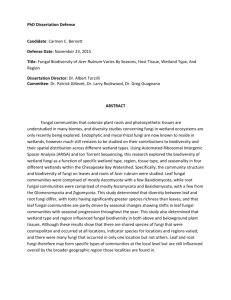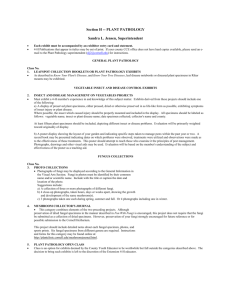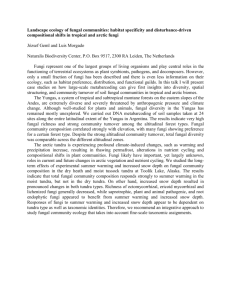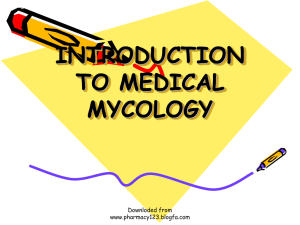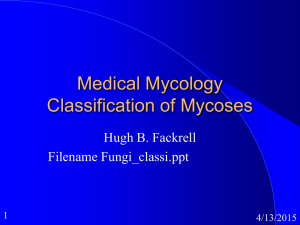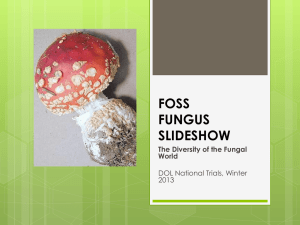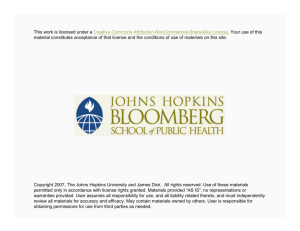Pathogenesis of fungal diseases (Mycoses)
advertisement
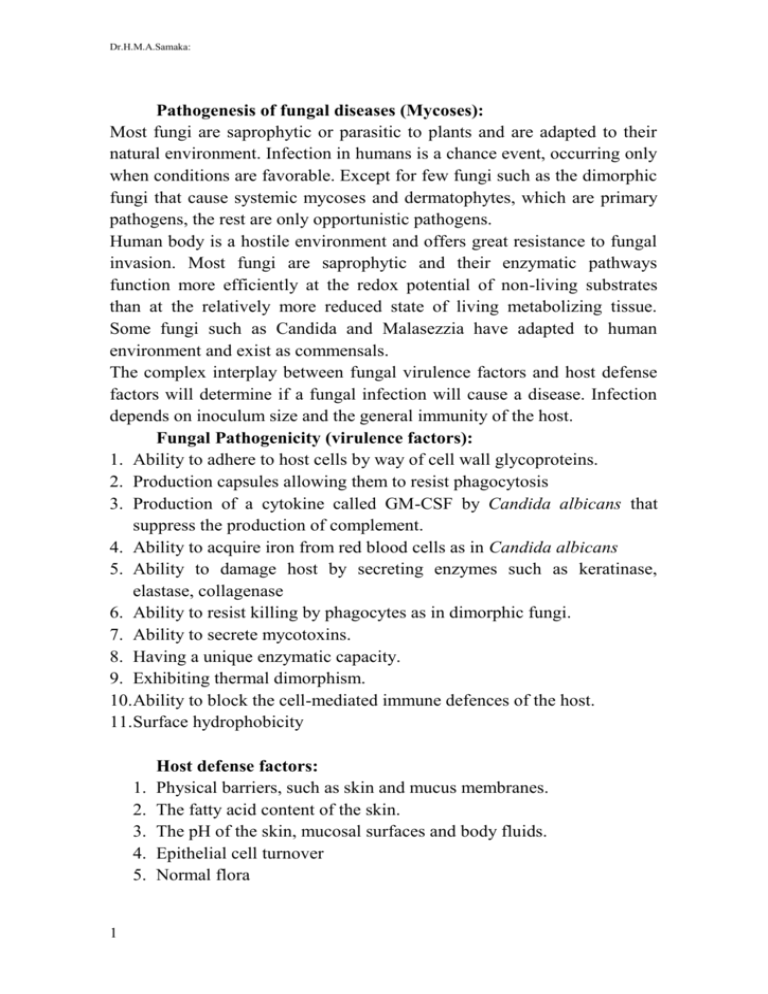
Dr.H.M.A.Samaka: Pathogenesis of fungal diseases (Mycoses): Most fungi are saprophytic or parasitic to plants and are adapted to their natural environment. Infection in humans is a chance event, occurring only when conditions are favorable. Except for few fungi such as the dimorphic fungi that cause systemic mycoses and dermatophytes, which are primary pathogens, the rest are only opportunistic pathogens. Human body is a hostile environment and offers great resistance to fungal invasion. Most fungi are saprophytic and their enzymatic pathways function more efficiently at the redox potential of non-living substrates than at the relatively more reduced state of living metabolizing tissue. Some fungi such as Candida and Malasezzia have adapted to human environment and exist as commensals. The complex interplay between fungal virulence factors and host defense factors will determine if a fungal infection will cause a disease. Infection depends on inoculum size and the general immunity of the host. Fungal Pathogenicity (virulence factors): 1. Ability to adhere to host cells by way of cell wall glycoproteins. 2. Production capsules allowing them to resist phagocytosis 3. Production of a cytokine called GM-CSF by Candida albicans that suppress the production of complement. 4. Ability to acquire iron from red blood cells as in Candida albicans 5. Ability to damage host by secreting enzymes such as keratinase, elastase, collagenase 6. Ability to resist killing by phagocytes as in dimorphic fungi. 7. Ability to secrete mycotoxins. 8. Having a unique enzymatic capacity. 9. Exhibiting thermal dimorphism. 10.Ability to block the cell-mediated immune defences of the host. 11.Surface hydrophobicity 1. 2. 3. 4. 5. 1 Host defense factors: Physical barriers, such as skin and mucus membranes. The fatty acid content of the skin. The pH of the skin, mucosal surfaces and body fluids. Epithelial cell turnover Normal flora Dr.H.M.A.Samaka: 6. Chemical barriers, such as secretions, serum factors 7. Most fungi are mesophilic and cannot grow at 37oC. 8. Natural Effector Cells (polymorphonuclear leucocytes) and the Professional Phagocytes (monocytes and macrophages) Factors predisposing to fungal infections: 1. Prolonged antibiotic therapy 2. Underlying disease (HIV infection, cancer, diabetes, etc.) 3. Age 4. Surgical procedures 5. Immunosuppressive drugs 6. Irradiation therapy 7. Indwelling catheters 8. Obesity 9. Drug addiction 10.Transplants Fungal Diseases (Mycoses): Mycoses can be conveniently studied as: 1. Superficial mycoses: a. Tinea versicolor (Malassezia furfur). b. Black piedra (Piedraia hortae). c. White piedra (Trichosporon) 2. Cutaneous mycoses: - Dermatophytosis Trichophyton Microsporum Epidermophyton 3. Subcutaneous mycoses a. Chromoblastomycosis b. Mycetoma c. Sporotrichosis (Sporothrix schenckii) 4. Systemic (deep) mycoses a. Blastomycosis (Blastomycetic dermatitis) b. Histoplasmosis (Histoplasma capsulatum) c. Coccidioidomycosis (Coccidioides immitis) 2 Dr.H.M.A.Samaka: d. Paracoccidioidomycosis 5. Opportunistic mycoses a. Candidiasis b. Cryptococcosis c. Aspergillosis 7. Fungal allergies 8. mycotoxicosis Laboratory diagnosis of mycoses: Specimen collection: specimen collection depends on the site affected. Different specimens include hair, skin scrapings, nail clippings, sputum, blood, CSF, urine, corneal scraping, discharge or pus from lesions and biopsy. All specimens must be transported to the laboratory without any delay to prevent bacterial overgrowth. In case of delay specimens except skin specimen, blood and CSF may be refrigerated for a short period. Infected hairs may be plucked using forceps. Those hairs that fluoresce under Wood’s lamp may be selectively plucked. Hairs may be collected in sterilized paper envelopes. Surface of the skin must be disinfected with spirit before specimen collection. The advancing edge of the lesion is scraped with the help of a blunt forceps and collected in sterilized paper envelopes. Discoloured or hyperkeratotic areas of nail may be scraped or diseased nail clipping may be collected in sterilized paper envelopes. Specimens from mucus membranes (oral) must be collected by gentle scraping and transported to laboratory in sterile tube containing saline. Swabs may be collected from vagina. Corneal scrapings may be collected using a fine needle and inoculated at bedside. Pus may be collected by aspiration; use of cotton swabs may give false positive microscopic results. urine may be collected in a sterile wide-mouthed container. Biopsy specimens must be transported in saline. In certain cases, pus or exudates must be looked for presence of granules. 3 Dr.H.M.A.Samaka: Microscopy: Microscopy is used to observe clinical specimens for the presence of fungal elements or to identify the fungus following culture. In the latter case, lactophenol cotton blue is stain of choice, which stains the fungal elements blue. Direct examination of clinical specimens could be stained or unstained. Wet mount: Candida may be observed in urine wet mounts 10-20% KOH mounts: Several specimens are subjected to KOH mount for direct examination. The material is mixed with 20% KOH on a slide and a cover slip is placed. The slide is then gently heated by passing through the flame 2-3 times. The slide is observed on cooling. KOH serves to digest the protein debris and clears keratinized tissue and increases the visibility. Addition of Dimethyl sulphoxide (DMSO) permits rapid clearing in the absence of heat. India ink: Capsules of Cryptococcus neoformans can be demonstrated by this negative staining technique. Periodic Acid-Schiff (PAS) stain: On staining by this stain, fungal elements appear bright magenta coloured while the background stains green. It is useful in staining tissue specimens. Giemsa’s stain: It is particularly useful in the detection of Histoplamsa capsulatum in the bone marrow smears. Haematoxylin and Eosin (H&E) stain: Useful for staining tissue sections. Gomori’s methenamine silver nitrate (GMS) stain: Outlines of the fungi are black, internal parts stain pink-black while the background stains light green. Candida and Aspergillus may be missed in H&E stained sections, therefore GMS stained sections are essential for tissue pathology. Gram stain: Candida is best demonstrated in clinical specimen by Gram stain. Immunofluorescence: Monoclonal antibody labelled with fluorescent dyes can be used to detect several fungi in the clinical specimens. Culture: One of the most common media used to culture fungi in laboratory is Sabouraud’s Dextrose Agar (SDA). It consists of peptone, 4 Dr.H.M.A.Samaka: dextrose and agar. High concentration of sugar and a low pH (4.5-5.5) prevents growth of most bacteria and makes it selective for fungi. Emmon’s modification of SDA contains 2% dextrose and has pH of 6.8. Other basal media to grow fungi include Potato Dextrose Agar, Malt Extract Agar etc. Most fungi are able to grow at room temperature while few pathogenic fungi (e.g, Cryptococcus, dimorphic fungi) can grow at 37oC. Saprophytic fungi grow much quickly than pathogenic fungi (e.g, dermatophytes). In such situations the saprophytic fungi can be inhibited by the addition of cycloheximide (actidione) to the SDA. Addition of antibiotics such as Chloramphenicol, Gentamicin or Streptomycin to SDA serves to inhibit bacterial multiplication. An example of SDA with cycloheximide and Chloramphenicol is Mycosel agar. Other specialized media used for different fungi include: Brain Heart Infusion Agar general isolation of fungi and conversion of dimorphic fungi. Inhibitory Mould Agar, an isolation medium with Chloramphenicol to suppress most bacteria. Caffeic Acid Agar and Birdseed Agar for isolation of Cryptococcus neoformans. Corn Meal Agar: Enhances production of chlamydospores in Candida albicans and formation of conidia in fungi. Trichophyton Agars: Used for selective identification of Trichophyton species. Dermatophyte Test Medium: Used for recovery of dermatophytes from clinical specimens. ‘CHROM agar Candida’ is useful in identification of Candida species. Conversion of mould to yeast phase must be demonstrated in vitro for identification of dimorphic fungi. Since some fungi grow slowly cultures should not be discarded for 4-6 weeks. Fungi are identified on the basis of colony morphology (including pigmentation) and microscopic observation by tease-mount preparation or slide culture technique. 5 Dr.H.M.A.Samaka: Serology: Detection of anti-fungal antibody is helpful in diagnosis of subcutaneous and systemic mycoses, prognosis and response to anti-fungal drugs. Different serologic techniques that are used include agglutination, immunodiffusion, counter-immunoelectrophoresis, complement fixation test, immunofluorescence, RIA and ELISA. Antigen detection: It is particularly useful in the diagnosis of Cryptococcal meningitis from CSF specimens. The test is performed by Latex Agglutination or immunodiffusion tests. It is also helpful in the detection of Aspergillus and Candida antigens in systemic infections. Skin tests: Delayed hypersensitivity reactions to fungal antigens can be demonstrated by skin tests. A positive skin does not necessarily indicate an active infection; it only indicates sensitization of the individual. Hence, its value is in epidemiological studies than diagnosis. These tests may be performed in Histoplasmosis, Candidiasis, Sporotrichosis, Coccidioidomycosis, Blastomycosis, Paracoccidiodomycosis and dermatophytosis. Molecular techniques: Newer techniques such as DNA hybridization, PCR are useful in diagnosis of mycoses in a shorter period as well as detect those fungi that are difficult or dangerous to cultivate in vitro. 6

